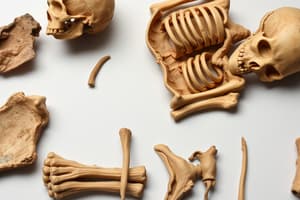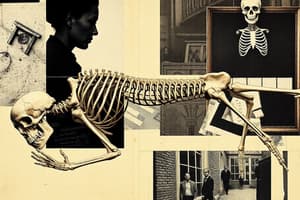Podcast
Questions and Answers
What is forensic anthropology?
What is forensic anthropology?
The study of human skeletal artifacts to understand life and death of people of the past
What is an oral tradition?
What is an oral tradition?
Practice of passing down stories from generation to generation by word of mouth
What is a historical record?
What is a historical record?
A document written by people of the past
Explain the main problem for historians studying early U.S. history.
Explain the main problem for historians studying early U.S. history.
What can forensic anthropologists learn by analyzing bones that we cannot learn from other types of historical sources?
What can forensic anthropologists learn by analyzing bones that we cannot learn from other types of historical sources?
What do archaeologists use old historical records for?
What do archaeologists use old historical records for?
What are soil stains?
What are soil stains?
Why was the original structure of James Fort hard to find?
Why was the original structure of James Fort hard to find?
Where was the true location of the fort?
Where was the true location of the fort?
Who discovered the fort's location?
Who discovered the fort's location?
Why did so many new settlers in Jamestown die so early on?
Why did so many new settlers in Jamestown die so early on?
What does the name JR1225B mean?
What does the name JR1225B mean?
What do archaeologists do during each step of the excavation process?
What do archaeologists do during each step of the excavation process?
Study Notes
Forensic Anthropology
- Definition: Study of human skeletal remains to gather insights about the lives and deaths of historical populations.
Oral Tradition
- Definition: Cultural practice where stories and knowledge are passed from generation to generation through spoken word.
Historical Records
- Definition: Documents created during past events by individuals, providing firsthand accounts and information.
Challenges in Early U.S. History
- Main issue: Low literacy rates led to a scarcity of written documents, complicating historical analysis.
Insights from Bones
- Forensic anthropologists can determine age, health status, gender, and signs of physical labor through skeletal analysis.
Role of Archaeologists
- Utilize historical records to supplement missing information that bones and artifacts may not reveal.
Soil Stains
- Occur when soil disturbances change the soil's color, indicating past human activity or burial sites.
James Fort Discovery Challenges
- Original structure hard to locate due to belief it had been washed away by the surrounding environment.
True Location of James Fort
- Accurately situated near the church tower, contradicting earlier assumptions about its location.
Discovery of Fort's Location
- William Kelso played a key role in identifying the fort's actual site through archaeological efforts.
Mortality in Jamestown
- High death rates among early settlers due to disease, malnutrition, starvation, conflicts with Indigenous peoples, and lack of preparedness.
Meaning of JR1225B
- JR signifies Jamestown rediscovery, with 1225B denoting a specific grave site feature within the excavation designation.
Archaeological Excavation Process
- Throughout excavation, archaeologists maintain meticulous records, photographs, diagrams, and maps to document findings systematically.
Studying That Suits You
Use AI to generate personalized quizzes and flashcards to suit your learning preferences.
Description
Test your knowledge of key concepts from Chapter 1 of 'Written in Bone'! This quiz covers essential definitions and explanations related to forensic anthropology, oral traditions, and historical records. Perfect for reinforcing your understanding and preparing for exams.





